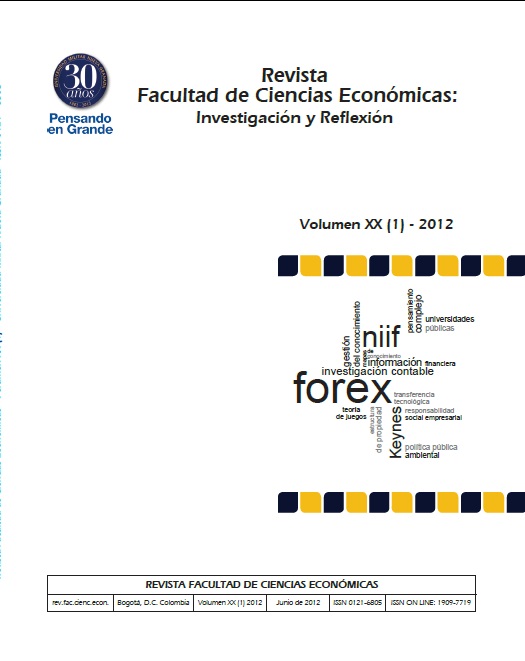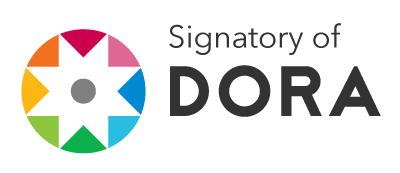Effects due to the process of IFRS 13 formulation: fair value measurements
Abstract
The IFRS 13 is the result of an ample period of debate and socialization of statements oriented to define criteria of fair value measurements. This rule arises in the convergence process performed among IASB and FASB, as a response to the necessity to homogenize this measurement bases, because its application is transversal in the group of the International Accounting Standards Board. For this purpose, the due process becomes a mechanism to legitimate practices that are expected to be of universal application. This paper analyses the evolution of conceptual and technical statements of IFRS13, since developments showed in the discussion draft of 2006. As a result, the effects from the due process in the premises, which finally were incorporated in the definitive standards, are evidenced.Downloads
References
Cairns, D., Massoudi, D., Taplin, R. & Tarca, A. (2011) IFRS fair value measurement and accounting policy choice in the United Kingdom and Australia. En: The British Accounting Review, 43: 1-21.
Castellanos, H. (2009) El valor razonable y la calidad de la información financiera. En: Vision Gerencial, 9 (2): 269-282.
Financial Accounting Standards Board - FASB (2011) Accounting Standard Update No. 2011-04 Fair Value Measurement (Topic 820) Disponible en:http://www.fasb.org/cs/BlobServer7blobcol=urldata&blobtable=MungoBlobs&blobkey=id&blobwhere=1175822486936&blobheader=application%2Fpdf
G-20 (2009) Declaration on strengthening the financial system -London, 2 April 2009-. Disponible en:http://www.g20.org/Documents/Fin_Deps_Fin_Reg_Annex_020409_-_1615_final.pdf
Georgiou, O. (2008) Gaining legitimacy: where has Fair Value Accounting come from? En: School of Accounting, Finance and Management. Disponible en:http://www.cardiff.ac.uk/carbs/conferences/abfh2008/omiros.pdf
International Accounting Standards Board - IASB (2006) Discussion Paper: Fair Value Measurement. United Kingdom.
International Accounting Standards Board - IASB (2009a) Exposure Draft ED/5: Fair Value Measurement. United Kingdom.
International Accounting Standards Board - IASB (2009b) Basis for Conclusions. Exposure Draft ED/5: Fair Value Measurement. United Kingdom.
International Accounting Standards Board - IASB (2010) Discussion Paper: Extractive Activities. United Kingdom: April 2010. Disponible en:http://www.ifrs.org/NR/rdonlyres/735F0CFC-2F50-43D3-B5A1-0D62EB5DDB99/0/DPExtractiveActivitiesApr10.pdf
International Accounting Standards Board - IASB (2011a) NIIF 13: Medición del Valor razonable. United Kingdom.
International Accounting Standards Board - IASB (2011b) Fundamentos de las Conclusiones. NIIF 13: Medición del Valor razonable. United Kingdom.
International Accounting Standards Board - IASB & Financial Accounting Standards Board - FASB (2002) Norwlak Agreement. Disponible en: http://www.fasb.org/cs/BlobServer7blobcoNurldata&blobtable = MungoBlobs&blobkey=id&blobwhere=1175819018817&blobheader=application%2Fpdf
International Accounting Standards Board - IASB & Financial Accounting Standards Board - FASB (2006) A Roadmap for Convergence between IFRSs and US GAAP-2006-2008 Memorandum of Understanding between the FASB and the IASB. Disponible en: http://www.iasplus.com/pressrel/0602roadmapmou.pdf
Jacques, R. (2004) The Secret Past of Fair Value: Lessons from History Applied to the French Case. En: Accounting in Europe, 1(1): 95-107.
Navarro, A. & Pérez, C. (2007) La repercusión del valor razonable de los bienes inmuebles en la utilidad de los estados financieros: una nota de investigación. En: Revista de Contabilidad-Spanish Accounting Review, 12 (1) Disponible:http://www.rc-sar.es/verPdf.php?articleId=190
Novoa, A., Scarlata, J. & Solé, J. (2009) Procyclicality and Fair Value Accounting. International Monetary Fund.
Patino, A. (2009) El valor razonable en las inversiones de grupos económicos. En: Cuadernos de contabilidad, enero-junio 2009, 67. Disponible:http://www.javeriana.edu.co/fcea/cuadernos_contab/vol10_n_26/vol10_26_3.pdf
Sarbanes-Oxley Act (2002) Disponible en:http://fl1.findlaw.com/news.findlaw.com/cnn/docs/gwbush/sarbanesoxley072302.pdf
Security and Exchange Comission - SEC (2008) Report and Recommendations Pursuant to Section 133 of the Emergency Economic Stabilization Act of 2008: Study on Mark-To-Market Accounting. Disponible en:http://www.sec.gov/news/studies/2008/marktomarket123008.pdf
Silva, B. & Azua, D. (2006) Avances sobre el concepto de valor razonable. En: CAPIV REVIEW, 4: 61-76.
Solomon, F. (1936) Revaluations of fixed assets, 1925-1934. En: National bureau of economic research, N° 62: 1-12.
Zeff, S. (2007) The SEC Rules Historical Cost Accounting: 1934 to the 1970s. Working paper, Rice University.
Zuñiga, F, Pacheco, L. & Díaz, J. (2009) Convergencia contable: cambios profundos en la contabilidad chilena: activo fijo, un caso a considerar. En: Capic Review, 7. Disponible:http://www.capic.cl/capic/images/vol7tema6.pdf











